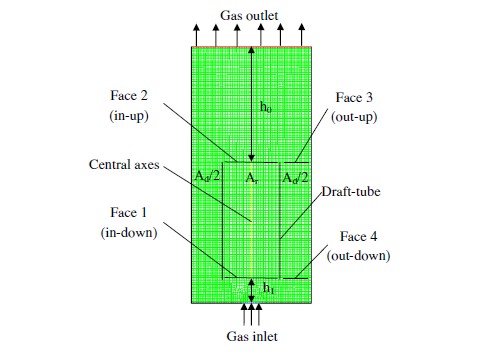Phototrophic bioprocesses are powerful tools for the production of valuable compounds from microalgae. Airlift column reactors, designed for the large-scale cultivation of phototrophic microalgae, are widely used in bioprocess industries. Recently a success of CFD application in determining hydrodynamic parameters of an airlift bioreactor with two different configurations is of great help to the design of several well mixed bioreactors for microalgal cultivation and evaluating light absorption capacity in the bioreactors. However, the understanding of the relationship among the inner structural parameters, multiphase fluid flow, and algal cultivation efficiency, is still limited.
In this work, researchers with Institute of Process Engineering (IPE) optimized the inner structure of a cylindrical airlift bioreactor using a two-dimensional axisymmetric CFD model. They designed an effective mixing process to improve the growth of Botryococcus braunii, a slow-growing, green microalgae species with the ability to produce a large amount of hydrocarbons (up to 75% of its dry biomass).
In the experiments, 2 L and 40 L cylindrical airlift bioreactors were constructed from glass columns that contained vertical stainless steel cylinders as the draft tubes and air spargers underneath the bioreactors for air supply. The simulation of the structure geometry and the calculation of the flow fluid were carried out using the software GAMBIT/FLUENT. The bioreactor structure was axial symmetric, and a two-dimensional axisymmetric model was utilized. A structured grid was implemented with a total number of 2774 cells within the 0.02*0.051 m computation domain (Fig. 1).
The simulation step was described as follows: (1) hydrodynamics in the bioreactor were simulated until a steady-state was achieved; (2) tracer was injected into the bioreactor from the inlet with a certain flow velocity for several seconds; (3) after injection, the massconcentration of the tracer on the face 1–4 shown in Fig. 1 was stimulated immediately. Algal growth was expressed in terms of dry biomass (g L-1), which was determined gravimetrically. The uniform experimental design method was used, and the formula U9 * (D = 0.198) was employed to design nine experiments in their study.
The simulation results showed that the hydrodynamic parameters changed with the inner structures of the bioreactor which, in turn, significantly affected the phototrophic growth of B. braunii cells. The CFD model developed in this study provides a powerful means for optimizing bioreactor design and scale-up without the need to perform numerous time-consuming bioreactor experiments. More information please see theBioresource Technology.

Fig.1. Structured grid of the 2 L draft-tube airlift bioreactor
 Search
Search




 京公网安备110402500047号
京公网安备110402500047号